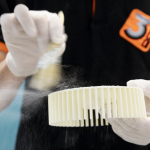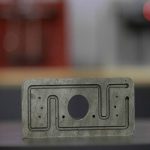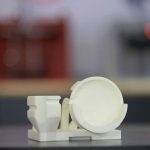WHY CHOOSE ADDITIVE MANUFACTURING?
Additive manufacturing (also known as 3D printing) offers numerous significant advantages that have revolutionized the manufacturing world. 3D printing enables the transformation of digitally created models into physical objects. Here are some key reasons to consider using this method:
ADVANTAGES OF ADDITIVE MANUFACTURING
Smarter Designs
With 3D manufacturing, parts with complex geometries can be easily produced. This allows the development of innovative solutions tailored to specific needs.
Cost Efficiency
Only the required amount of material is used, and the need for assembly processes is reduced. This offers a more economical approach, especially in low-volume or custom production.
Faster Time-to-Market
Shorter production cycles speed up product development, allowing companies to quickly respond to market demands. 3D printing technology enables rapid and personalized production solutions.
Quick Design Changes
Design modifications can be implemented instantly without significant delays or high costs.
Minimal Material Waste
Materials are used only as needed, greatly reducing waste compared to traditional methods. Products made with 3D printers generate less waste than conventional production techniques.
COMMON APPLICATIONS OF ADDITIVE MANUFACTURING
Prototyping
Used for design validation, functional testing, and rapid prototype development.
Customized Products
Custom-made products tailored to personal needs, such as dental braces, prosthetics, and wearable devices.
Aerospace and Aviation
Used for producing lightweight, complex components such as turbine parts and structural connectors while ensuring material efficiency and high performance.
Automotive
3D printing is used in the automotive sector to produce custom parts and spare components.
Healthcare Sector
Patient-specific implants, surgical guides, and medical models are produced to improve surgical precision.
Tooling and Manufacturing Aids
Fixtures, molds, and various auxiliary equipment for manufacturing processes can be produced quickly and cost-effectively.
Consumer Products
Used for manufacturing personalized consumer items such as footwear, jewelry, and decorative home goods.
Spare Parts Production
Spare parts are produced on-demand, reducing the need for inventory and enhancing local manufacturing capabilities.
CONTINUOUSLY EXPANDING APPLICATIONS
These examples demonstrate the versatility of additive manufacturing. As the technology evolves and becomes more accessible, new applications tailored to various industries continue to emerge rapidly.
Design File Requirement: To print a 3D model, you must prepare your design in STL, STEP, or IGS format.
With this approach, you can easily print engineering prototypes, artistic sculptures, and functional parts using STL 3D printing.
Bring Your Designs to Life with Additive Manufacturing
3D printers use advanced technologies to turn digital designs into physical reality. The 3D printing method stands out with its remarkable advantages. Thanks to rapid prototyping, customized production, material efficiency, and flexible design capabilities, this innovative method makes a difference across industries.
Additive manufacturing creates new opportunities by offering shorter production times, cost-effective solutions, and personalized production capabilities. Choosing additive manufacturing paves the way for innovation and creativity. With the ability to make quick design adjustments and easily produce complex components, businesses can accelerate their product development processes and enhance their competitive edge.





